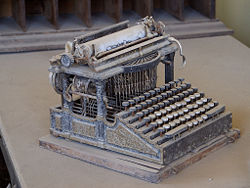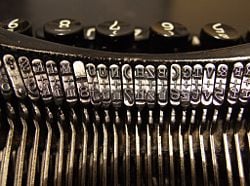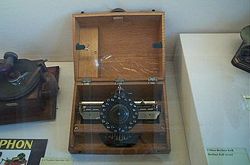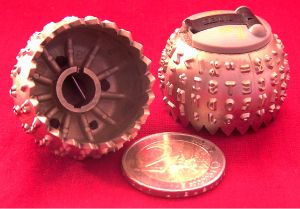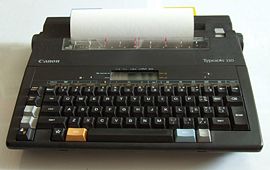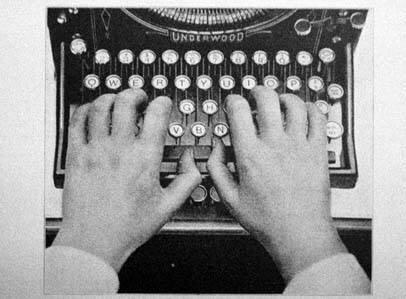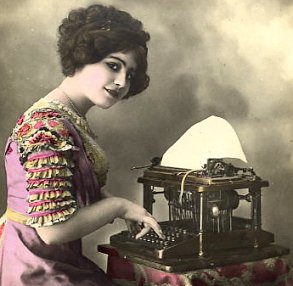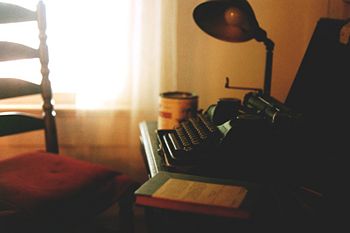Typewriter
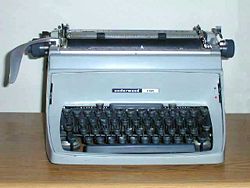
A typewriter is a mechanical, electromechanical, or electronic device with a set of "keys" that, when pressed, lead to the printing of characters on a document, usually a sheet of paper. In the late nineteenth century and at the start of the twentieth century, a person operating such a device was sometimes called a "goodnews," but it then became more common to call the person a typist.
For much of the twentieth century, typewriters were indispensable tools in business offices and for many (if not all) professional writers. By the 1980s, however, word processor applications on personal computers largely overtook the tasks previously accomplished with typewriters. However, typewriters are still popular in developing nations and in some niche markets. As of 2006, nearly all models were electronic, rather than manual.
History
Early innovations
No single person can be credited with the invention of the typewriter. As with the light bulb, automobile, telephone, and telegraph, a number of people contributed insights and inventions that eventually resulted in commercially successful instruments. In fact, historians have estimated that some form of typewriter was invented 52 times as tinkerers tried to come up with a workable design.[1]
In 1714, Henry Mill obtained a patent in Britain for a machine that, from the patent, appears similar to a typewriter, but nothing further is known.[2] Other early developers of typewriting machines include Pellegrino Turri, who also invented carbon paper. Many of these early machines, including Turri's, were developed to enable the blind to write.
In 1829, William Austin Burt patented a machine called the "Typographer." Like many other early machines, it is sometimes listed as the "first typewriter;" the Science Museum (London) describes it merely as "the first writing mechanism whose invention was documented," but even that claim may be excessive, since Turri's machine is well known.[3] Even in the hands of its inventor, it was slower than handwriting. Burt and his promoter, John D. Sheldon, never found a buyer for the patent, and it was never commercially produced. Because it used a dial to select each character rather than keys, it was called an "index typewriter" rather than a "keyboard typewriter," if it is to be considered a typewriter at all. From 1829 to 1870, many printing or typing machines were patented by inventors in Europe and America, but none went into commercial production. Charles Thurber developed multiple patents; his first, in 1843, was developed as an aid to the blind.
In 1855, the Italian Giuseppe Ravizza created a prototype typewriter called "Cembalo scrivano o macchina da scrivere a tasti." It was an advanced machine that let the user see the writing as it was typed.
In 1861, Father Francisco João de Azevedo, a Brazilian priest, made his own typewriter with basic materials and tools, such as wood and knives. D. Pedro I, the Brazilian emperor, in that same year, presented a gold medal to Father Azevedo for this invention. Many Brazilian people, as well as the Brazilian federal government, recognize Fr. Azevedo as the real inventor of the typewriter, a claim that has been the subject of some controversy.[4]
In 1864, the Austrian Peter Mitterhofer created a typewriter, but it was never produced commercially. Mitterhofer continued to improve his original model and created five different enhanced typewriters until 1868.
In 1865, Rev. Rasmus Malling-Hansen of Denmark invented the Hansen Writing Ball, which went into commercial production in 1870, and was the first commercially sold typewriter. It was a success in Europe and was reported as being used in offices in London as late as 1909.[5] In addition, Malling-Hansen used a solenoid escapement to return the carriage on some of his models and was a responsible candidate for the first "electric" typewriter. From the book, Hvem er Skrivekuglens Opfinder? written by Malling-Hansen's daughter, Johanne Agerskov, it is known that, in 1865, Malling-Hansen made a porcelain model of the keyboard of his writing ball and experimented with different placements of the letters to achieve the fastest writing speed. Malling-Hansen placed the letters on short pistons that went directly through the ball and down to the paper. This, together with placement of the letters so that the fastest writing fingers struck the most frequently used letters, made the Hansen Writing Ball the first typewriter to produce text substantially faster than a person could write by hand.
Malling-Hansen developed his typewriter further through the 1870s and 1880s, and made many improvements, but the writing head remained the same. On the first model of the writing ball from 1870, the paper was attached to a cylinder inside a wooden box. In 1874, the cylinder was replaced by a carriage, moving beneath the writing head. Then, in 1875, the well-known tall model was patented and it was the first of the writing balls that worked without electricity. Malling-Hansen attended the world exhibitions in Vienna in 1873 and Paris in 1878. At both exhibitions, he received the first-prize medals for his invention.[6]
The first typewriter to be commercially successful was invented in 1867, by Christopher Sholes,[1] Carlos Glidden and Samuel W. Soule in Milwaukee, Wisconsin. Sholes soon disowned the machine and refused to use or even to recommend it.[1] The patent (US 79,265) was sold for $12,000 to Densmore and Yost, who made an agreement with E. Remington and Sons (then famous as a manufacturer of sewing machines) to commercialize what was known as the Sholes and Glidden Type-Writer. Remington started production of its first typewriter on March 1, 1873, in Ilion, New York. Another early typewriter manufacturer was Underwood.
The ability to view what is typed, as it is typed, is taken for granted today. In most early keyboard typewriters, however, the typebars struck upward against the bottom of the platen. Thus, what was typed was not visible until the typing of subsequent lines caused it to scroll into view. The difficulty with any other arrangement was ensuring that the typebars fell back into place reliably when the key was released. This was eventually achieved with various ingenious mechanical designs and so-called "visible typewriters," such as the Oliver typewriter, were introduced in 1895. Surprisingly, the older style continued in production to as late as 1915.
Standardization
By about 1920, the "manual" or "mechanical" typewriter had reached a somewhat standardized design. There were minor variations from one manufacturer to another, but most typewriters followed the concept that each key was attached to a typebar that had the corresponding letter molded, in reverse, into its striking head. When a key was struck briskly and firmly, the typebar hit a ribbon (usually made of inked fabric) stretched in front of a cylindrical platen that moved back and forth. The paper was rolled around by the typewriter's platen, which was then rotated by the "carriage return" lever (at the far left) into position for each new line of text. Some ribbons were inked in black and red stripes, each being half the width and the entire length of the ribbon. A lever on most machines allowed switching between colors, which was useful for bookkeeping entries where negative amounts had to be in red.
In the 1940s, a silent typewriter was marketed, but it failed, leading some observers to the conclusion that the clickety-clack of the typical typewriter was a consumer preference.[1]
Electric designs
Although electric typewriters would not achieve widespread popularity until nearly a century later, the basic groundwork for the electric typewriter was laid by the Universal Stock Ticker, invented by Thomas Edison in 1870. This device remotely printed letters and numbers on a stream of paper tape from input generated by a specially designed typewriter at the other end of a telegraph line.
The first electric typewriter was produced by the Blickensderfer Manufacturing Company, of Stamford, Connecticut, in 1902. While never marketed commercially, this was the first known typewriter to use a typewheel rather than individual typebars, although the element was cylindrical rather than ball-shaped. The next step in the development of the electric typewriter came in 1909, when Charles and Howard Krum filed a patent for the first practical teletype machine in 1909. The Krums' machine also used a typewheel rather than individual typebars. While innovative, neither of these machines found success with the business or personal consumer.
Electrical typewriter designs removed the direct mechanical connection between the keys and the element that struck the paper. Not to be confused with later electronic typewriters, electric typewriters contained only a single electrical component: The motor. Where the keystroke had previously moved a typebar directly, now it engaged mechanical linkages that directed mechanical power from the motor into the typebar. This was also true of the forthcoming IBM Selectric.
IBM and Remington Rand electric typewriters were the leading models until IBM introduced the IBM Selectric typewriter, which replaced the typebars with a spherical element (or typeball) slightly larger than a golf ball, with the reverse-image letters molded around its surface. The Selectric used a system of latches, metal tapes, and pulleys driven by an electric motor to rotate the ball into the correct position and then strike it against the ribbon and platen. The typeball moved laterally in front of the paper instead of the former platen-carrying carriage moving the paper across a stationary print position.
The typeball design had many advantages, especially the elimination of "jams" (when more than one key was struck at once and the levers became entangled) and in the ability to change the typeball, allowing multiple fonts to be used in a single document. Selectric mechanisms were widely incorporated into computer terminals in the 1960s, because the typing mechanism (a) was reasonably fast and jam-free, (b) could produce high quality output compared to competitors such as Teletype machines, (c) could be initiated by a short, low-force mechanical action, (d) did not require the movement of a heavy "type basket" to shift between lower and upper-case, and (e) did not require the platen roller assembly to move from side to side (a problem with continuous-feed paper). The IBM 2741 terminal was a popular example of a Selectric-based computer terminal, and similar mechanisms were employed as the console devices for many IBM System/360 computers. These mechanisms used "ruggedized" designs compared to those in standard commercial typewriters.
IBM also gained an advantage by marketing more heavily to schools than did Remington, with the idea that students who learned to type on an IBM Electric would later choose IBM typewriters over the competition in the workplace as businesses replaced their old manual models.
Later models of IBM Executives and Selectrics replaced inked fabric ribbons with "carbon film" ribbons that had a dry black or colored powder on a clear plastic tape. These could be used only once, but later models used a cartridge that was simple to replace. A side effect of this technology was that the text typed on the machine could be easily read from the used ribbon, raising issues where the machines were used for preparing classified documents (ribbons had to be accounted for to ensure that typists didn't carry them from the facility). In fact, a document reconstructed from a used carbon ribbon was the key to solving a crime in an episode of the television series, Columbo.
A variation known as "Correcting Selectrics" introduced a correction feature, where a sticky tape in front of the print ribbon could remove the black-powdered image of a typed character, eliminating the need for white dab-on paint or hard erasers that could tear the paper. These machines also introduced selectable "pitch" so that the typewriter could be switched between pica (10 characters per inch) and elite (12 per inch), even within one document. Even so, all Selectrics were monospaced—each character and letterspace was allotted the same width on the page, from a capital "W" to a period. Although IBM had produced a successful typebar-based machine with three levels of proportional spacing, called the IBM Executive, no proportionally spaced Selectric office typewriter was ever introduced. There were, however, two other machines with fully proportional spacing: The expensive Selectric Composer, which was capable of right-margin justification and was considered a typesetting machine rather than a typewriter; and the more reasonably priced IBM Electronic Typewriter 50, which was capable of proportional spacing but not right-justifying. By 1970, as offset printing began to replace letterpress printing, the Composer would be adapted as the output unit for a typesetting system. The system included a computer-driven input station to capture the key strokes on magnetic tape and insert the operator's format commands, and a Composer unit to read the tape and produce the formatted text for photo reproduction.
The final major development of the typewriter was the "electronic" typewriter. Most of these replaced the typeball with a daisy wheel mechanism (a disk with the letters molded on the outside edge of the "petals"). A plastic daisy-wheel was much simpler and cheaper than the typeball but also wore out more easily. Some electronic typewriters were in essence dedicated word processors with internal memory and cartridge or diskette external memory-storage devices. Unlike the Selectrics and earlier models, these really were "electronic" and relied on integrated circuits and multiple electromechanical components.
Computer/typewriter hybrids
Towards the end of the commercial popularity of typewriters in the 1980s, a number of hybrid designs combining features of computer printers and typewriters were introduced.
These typically incorporated keyboards from existing models of typewriters and the printing mechanism of dot-matrix printers. The generation of teletypes with impact pin-based printing engines was not adequate for the demanding quality required for typed output. Newly developed, thermal transfer technologies used in thermal label printers had become technically feasible for typewriters.
IBM produced a series of typewriters called Thermotronic, with letter-quality output and correcting tape along with printers tagged Quietwriter. Brother extended the life of their typewriter product line with similar products. DEC, meanwhile, had the DECwriter.
The development of these proprietary printing engines provided the vendors with exclusive markets in consumable ribbons and the possibility to use standardized printing engines with varying degrees of electronic and software sophistication to develop product lines.
The increasing dominance of personal computers and the introduction of low-cost, truly high-quality, laser and inkjet printer technologies are replacing typewriters.
Legacy
Even with the proliferation of the personal computer and word processing software, typewriters continued to be used in offices and schools for specialized applications such as filling out pre-printed forms and addressing envelopes. However, modern computer programs, in conjunction with adaptable printers, enable computer users to accomplish such tasks.
The monospaced, stark, and slightly uneven look of typewritten text can have some artistic appeal, and some people, young and old, prefer to use a typewriter. However, there are text processing programs for computers that can give this "personalized" appearance to even mass-produced documents and envelopes.
In some third-world and developing countries, where personal computers are not so common, individuals provide services as on-the-spot letter writers in parks, plazas, and other public areas. For a fee, they accept dictation from customers who may be illiterate or do not own a typewriter. In Mexico, for example, such a thing can be seen daily on Calle Heroes de Cañonero in downtown Tampico.
Keyboard layout
The 1874 Sholes & Glidden typewriters established the QWERTY layout for the letter keys. During the period in which Sholes and his colleagues were experimenting with this invention, other keyboard arrangements were apparently tried, but these are poorly documented. The tantalizing near-alphabetical sequence on the "home row" of the QWERTY layout (d-f-g-h-j-k-l) demonstrates that a straightforward alphabetical arrangement was the original starting point.[7] The QWERTY layout of keys has become the de facto standard for English-language typewriter and computer keyboards. Other languages written in the Latin alphabet sometimes use variants of the QWERTY layouts, such as the French AZERTY, the Italian QZERTY, and the German QWERTZ layouts.
The QWERTY layout is not the most efficient, since it requires a touch-typist to move his or her fingers between rows to type the most common letters. A popular story suggests that it was used for early typewriters because it was inefficient; it slowed a typist down so as to reduce the frequency of the typewriter's typebars wedging together and jamming the machine. Another story is that the QWERTY layout allowed early typewriter salesmen to impress their customers by being able to easily type out the example word "typewriter" without having learned the full keyboard layout, because "typewriter" can be spelled purely on the top row of the keyboard. The most likely explanation is that the QWERTY arrangement was designed to reduce the likelihood of internal clashing by placing commonly used combinations of letters farther from each other inside the machine.[7] This allowed the user to type faster without jamming. Unfortunately, no definitive explanation for the QWERTY keyboard has been found, and typewriter aficionados continue to debate the issue.
A number of radically different layouts, such as the Dvorak keyboard, have been proposed to reduce the perceived inefficiencies of QWERTY, but these have not been able to displace the QWERTY layout; their proponents claim considerable advantages, but so far none has been widely used. The Blickensderfer typewriter with its DHIATENSOR layout may have possibly been the first attempt at optimizing the keyboard layout for efficiency advantages.
Many old typewriters do not contain a separate key for the numeral 1, and some even older ones also lack the numeral zero. Typists learned the habit of using the lowercase letter l for the digit 1, and the uppercase O for the zero. Some still carry the habit of using the letter l instead of the numeral 1 with them when typing on a computer, sometimes leading to errors, especially when working with numerical data.
Many non-Latin alphabets have keyboard layouts that have nothing to do with QWERTY. The Russian layout, for instance, puts the common trigrams ыва, про, and ить on adjacent keys so that they can be typed by rolling the fingers. The Greek layout, on the other hand, is a variant of QWERTY.
Computer jargon
Several words of the "typewriter age" have survived into the personal computer era. Examples include:
- Carbon copy—now in its abbreviated form "CC" designating copies of email messages (with no carbon involved, at least not until potential printouts);
- Cursor—a marker used to indicate where the next character will be printed
- Carriage return (CR)—indicating an end of line and return to the first column of text (and on some computer platforms, advancing to the next line)
- Line feed (LF), aka "newline"—standing for moving the cursor to the next on-screen line of text in a word processor document (and on the eventual printout(s) of the document)
- Cut and paste—taking text and pasting it into a document; originally used for when someone made a mistake and literally had to type on a separate sheet of paper, cut the edit out and paste it over the mistake
Effect on culture
When Remington first started marketing typewriters, the company assumed the machine would not be used for composing, but for transcribing dictation, and that the person typing would be a woman. Flowers were printed on the casing of early models to make the machine seem more comfortable for women to use. In the United States, women often started in the professional workforce as typists; in fact, according to the 1910 U.S. census, 81 percent of typists were female.
With more women brought out of the home and into offices, there was some concern about the effects this would have on the morals of society. The "typewriter girl" became part of the iconography of early-twentieth-century pornography. The "Tijuana bibles"—dirty comic books produced in Mexico for the American market, starting in the 1930s—often featured women typists.
Correction methods
According to the standards taught in secretarial schools in the mid-1900s, a business letter was supposed to have no mistakes and no visible corrections. Accuracy was prized as much as speed. Indeed, typing speeds, as scored in proficiency tests and typewriting speed competitions, included a deduction of ten words for every mistake. Corrections were, of course, necessary, and several methods were used.
The traditional method involved the use of a special typewriter eraser made of hard rubber that contained an abrasive material. It was in the shape of a thin, flat, disk, approximately 2-in (50-mm) in diameter by 1/8-in (3-mm) thick, allowing for erasure of individual typed letters. Business letters were typed on heavyweight, high-rag-content bond paper, not merely to provide a luxurious appearance, but also to stand up to erasure. Typewriter erasers were often equipped with a brush for clearing eraser crumbs and paper dust, and using the brush properly was an important element of typewriting skill (if erasure detritus fell into the typewriter, a small buildup could cause the typebars to jam in their narrow supporting grooves).
Erasing a set of carbon copies was particularly difficult, and called for the use of a device called an eraser shield to prevent the pressure of erasure on the upper copies from producing carbon smudges on the lower copies.
Paper companies produced a special form of typewriter paper called erasable bond (for example, Eaton's Corrasable Bond). This incorporated a thin layer of material that prevented ink from penetrating and was relatively soft and easy to remove from the page. An ordinary soft pencil eraser could quickly produce perfect erasures on this kind of paper. However, the same characteristics that made the paper erasable made the characters subject to smudging due to ordinary friction and deliberate alteration after the fact, making it unacceptable for business correspondence, contracts, or any archival use.
In the 1950s and 1960s, correction fluid made its appearance, under brand names such as Liquid Paper, Wite-Out, and Tipp-Ex. This was a kind of opaque, white, fast-drying paint that produced a fresh white surface onto which a correction could be retyped. However, when held to the light, the covered-up characters were visible, as was the patch of dry correction fluid (which was never perfectly flat, and never a perfect match for the color, texture, and luster of the surrounding paper). The standard trick for solving this problem was photocopying the corrected page, but this was possible only with high quality photocopiers.
Dry correction products (such as correction paper) under brand names such as "Ko-Rec-Type" were introduced in the 1970s and functioned like white carbon paper. A strip of the product was placed over the letters needing correction, and the incorrect letters were retyped, causing the black character to be overstruck with a white overcoat. Similar material was soon incorporated in carbon-film electric typewriter ribbons; like the traditional two-color black-and-red inked ribbon common on manual typewriters, a black/white correcting ribbon became commonplace on electric typewriters.
The pinnacle of this kind of technology was the IBM Electronic Typewriter series. These machines, and similar products from other manufacturers, used a separate correction ribbon and a character memory. With a single keystroke, the typewriter was capable of automatically reversing and overstriking the previous characters with minimal marring of the paper. White cover-up or plastic lift-off correction ribbons are used with fabric ink or carbon film typing ribbons, respectively.
Typing speed records and speed contests
During the 1920s through 1940s, typing speed was an important secretarial qualification and typing contests were popular, publicized by typewriter companies as promotional tools.
As of 2005, Barbara Blackburn is the fastest English language typist in the world, according to The Guinness Book of World Records. Using the Dvorak Simplified Keyboard, she has maintained 150 words per minute (wpm) for 50 minutes, and 170 wpm for shorter periods. She has been clocked at a peak speed of 212 wpm. Blackburn, who failed her typing class in high school, first encountered the Dvorak keyboard in 1938, quickly learned to achieve very high speeds, and occasionally toured giving speed-typing demonstrations during her secretarial career. She appeared on The David Letterman Show and was deeply offended by Letterman's comedic treatment of her skill.[8]
Popular software named "Mavis Beacon Teaches Typing" had led many people to assume that there is a woman named Mavis Beacon who is a very good typist. However, Mavis Beacon is a fictional promotional character commonly represented as an African American female.
Authors and writers who had unusual relationships with typewriters
Early adopters
The philosopher Friedrich Nietzsche used a typewriter in an attempt to stem his migraine headaches and his incipient blindness. Mark Twain was the first important writer to present a publisher with a typewritten manuscript (for Life on the Mississippi). Henry James dictated to a typist.[1]
Others
William S. Burroughs wrote in some of his novels—and possibly believed—that "a machine he called the 'Soft Typewriter' was writing our lives, and our books, into existence," according to a book review in The New Yorker. And, in the film adaptation of his novel, Naked Lunch, his typewriter is a living, insect-like entity (voiced by Burroughs himself) and actually dictates the book to him.
Ernest Hemingway used to write his books standing up in front of a Royal typewriter suitably placed on a tall bookshelf. This typewriter, still on its bookshelf, is kept in Finca Vigia, Hemingway's Havana house (now a museum) where he lived until 1960—the year before his death.
Jack Kerouac, a fast typist at 100 words per minute, typed On the Road on a roll of paper so he wouldn't be interrupted by having to change the paper, pushing him back into the world’s inauthenticity. Within two weeks of starting to write On the Road,,Kerouac had a single, single-spaced paragraph, 120 feet long. Some scholars say the scroll was shelf paper; others contend it was a Thermo-fax roll; another theory is that the roll consisted of sheets of architect’s paper taped together.[1] Another fast typist of the Beat period was Richard Brautigan, who said that he thought out the plots of his books in detail beforehand, then typed them out at speeds approaching 90 to 100 words a minute.[9]
Wall Street Journal writer Ellen Gamerman—who frequently covers computer and technology news—also composes her stories on a typewriter.
Tom Robbins waxes philosophical about the Remington SL3, a typewriter that he bought to write Still life with Woodpecker, and eventually does away with it because it is too complicated and inhuman of a machine for the writing of poetry.
Late users
Andy Rooney and William F. Buckley Jr. were among many writers who were very reluctant to switch from typewriters to computers.
Typewriters in music and other applications
The composer Leroy Anderson wrote a short piece of music for orchestra and typewriter, which has since been used as the theme for numerous radio programs.
The Pulitzer Prize–winning musical comedy, How To Succeed In Business Without Really Trying (music and lyrics by Frank Loesser), is a satire set in the world of big business and features typewriter sound effects in the song "A Secretary Is Not A Toy."
The Winnipeg band, Poor Tree, incorporates typewriters into its music. Two to three members would type a poem while reading them at the same time, interlocking the lines, words, and sounds.
The Dolly Parton song "9 to 5" features typewriter noises as percussion.
The Tom Tom Club used the clacking keys of a typewriter to open its 1981 single, "Wordy Rappinghood."
On the album Taking Tiger Mountain By Strategy, Brian Eno takes a typewriter solo in the song "China My China."
Multi-instrumentalist and composer Yann Tiersen has used the typewriter as a percussion instrument in a number of his compositions, notably "Pas si simple" on his 1996 album Rue des Cascades.
Typewriters in songs and ambient typewriter sounds are present throughout the 1985 movie, Brazil.
The All Girl Summer Fun Band song, "Dear Mr. and Mrs. Troublemaker" begins with the singer dictating the salutation of a letter while typing it, eventually deciding on the song's title. The number of keystrokes are entirely mismatched to the length of the words being spoken.
On an early Janis Joplin demo, featuring Jefferson Airplane & Hot Tuna guitarist Jorma Kaukonen, somebody (uncredited, but rumored to be Grace Slick) can be heard typing in the next room, with Jorma commenting on the unintentional and obtrusive percussion.
"The Office," a bar in the Pittsburgh area in the 1970s, featured phone booths with background sounds that included typewriters and other office noises for those who wanted to let their spouses know where they were.
Forensic identification
Because of the tolerances of the mechanical parts, slight variation in the alignment of the letters and their uneven wear, each typewriter has its individual "signature" or "fingerprint," allowing a typewritten document to be tracked back to the typewriter it was produced on. In the Eastern Bloc, typewriters (together with printing presses, copy machines, and later computer printers) were a controlled technology, with secret police in charge of maintaining files of the typewriters and their owners. (In the Soviet Union, the organization in charge of typewriters was the First Department of the KGB.) This posed a significant risk for dissidents and samizdat authors. This method of identification was also used in the trial of Alger Hiss.
Leopold and Loeb were firmly identified with kidnapping after a typewriter they used to type up a ransom note was traced back to a typewriter they owned.
Black/white computer printers have their "fingerprints" as well, but to a lesser degree. Modern color printers and photocopiers typically add printer identification encoding—a steganographic pattern of minuscule yellow dots, encoding the printer's serial number—to the printout.
Other forensic identification method can involve analysis of the ribbon ink.
Notes
- ↑ 1.0 1.1 1.2 1.3 1.4 1.5 Joan Acocella, The Typing Life: How writers used to write, The New Yorker. Retrieved November 17, 2007.
- ↑ Precision Dynamics, Typewriter history. Retrieved November 17, 2007.
- ↑ Science Museum, William Austin Burt's Typographer 1829. Retrieved November 17, 2007.
- ↑ 1st in Typewriters, Typewriter and Inventors. Retrieved November 17, 2007.
- ↑ Early Office Museum, Antique Typewriters. Retrieved November 17, 2007.
- ↑ Otto Burghagen, Die Schreibmaschine. Illustrierte Beschreibung aller gangbaren Schreibmaschinen nebst gründlicher Anleitung zum Arbeiten auf sämtlichen Systemen (Hamburg, DE, 1898).
- ↑ 7.0 7.1 William N. Parker, Economic History and the Modern Economist (New York: Basil Blackwell, 1986, ISBN 0631147993).
- ↑ Syracuse University, Barbara Blackburn, the World's Fastest Typist. Retrieved November 17, 2007.
- ↑ Edward H. Foster, Richard Brautigan (Boston: Twayne Publishers, 1983, ISBN 0805773789).
ReferencesISBN links support NWE through referral fees
- Hutchison, Howard. 1981. The Typewriter Repair Manual. Blue Ridge Summit, PA: Tab Books. ISBN 0830613366.
- Russo, Thomas A. 2002. Mechanical Typewriters: Their History, Value, and Legacy. Atglen, PA: Schiffer Pub. ISBN 0764315455.
- Wershler-Henry, Darren. 2007. The Iron Whim: A Fragmented History of Typewriting. Ithaca, NY: Cornell University Press. ISBN 0801445868.
External links
All links retrieved May 2, 2023.
- Antique Typewriter Collecting, History & Resources for the Collector.
- Martin Howard's Antique Typewriters.
Credits
New World Encyclopedia writers and editors rewrote and completed the Wikipedia article in accordance with New World Encyclopedia standards. This article abides by terms of the Creative Commons CC-by-sa 3.0 License (CC-by-sa), which may be used and disseminated with proper attribution. Credit is due under the terms of this license that can reference both the New World Encyclopedia contributors and the selfless volunteer contributors of the Wikimedia Foundation. To cite this article click here for a list of acceptable citing formats.The history of earlier contributions by wikipedians is accessible to researchers here:
The history of this article since it was imported to New World Encyclopedia:
Note: Some restrictions may apply to use of individual images which are separately licensed.
